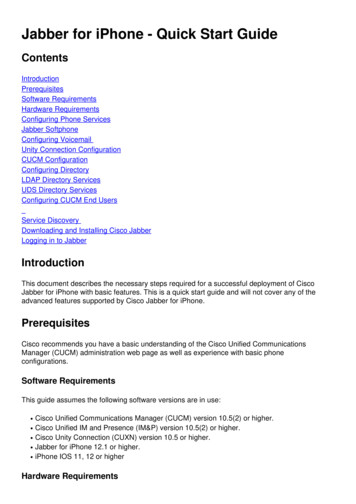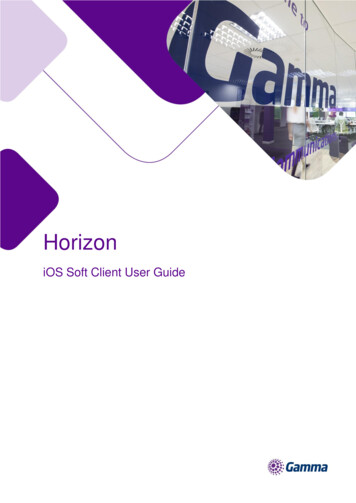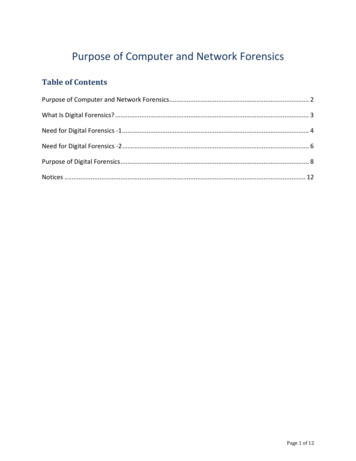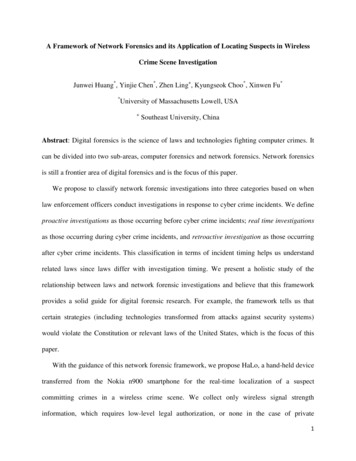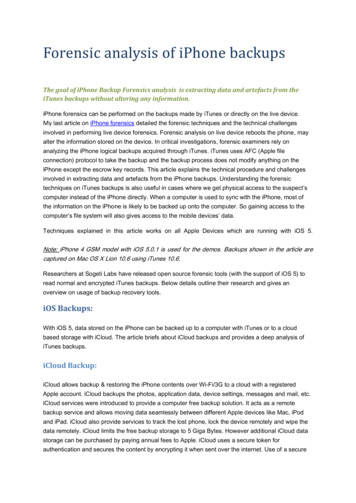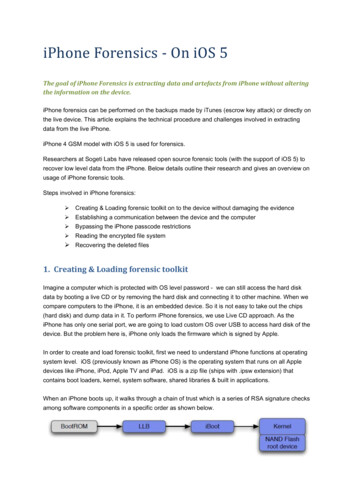
Transcription
iPhone Forensics - On iOS 5The goal of iPhone Forensics is extracting data and artefacts from iPhone without alteringthe information on the device.iPhone forensics can be performed on the backups made by iTunes (escrow key attack) or directly onthe live device. This article explains the technical procedure and challenges involved in extractingdata from the live iPhone.iPhone 4 GSM model with iOS 5 is used for forensics.Researchers at Sogeti Labs have released open source forensic tools (with the support of iOS 5) torecover low level data from the iPhone. Below details outline their research and gives an overview onusage of iPhone forensic tools.Steps involved in iPhone forensics: Creating & Loading forensic toolkit on to the device without damaging the evidence Establishing a communication between the device and the computer Bypassing the iPhone passcode restrictions Reading the encrypted file system Recovering the deleted files1. Creating & Loading forensic toolkitImagine a computer which is protected with OS level password - we can still access the hard diskdata by booting a live CD or by removing the hard disk and connecting it to other machine. When wecompare computers to the iPhone, it is an embedded device. So it is not easy to take out the chips(hard disk) and dump data in it. To perform iPhone forensics, we use Live CD approach. As theiPhone has only one serial port, we are going to load custom OS over USB to access hard disk of thedevice. But the problem here is, iPhone only loads the firmware which is signed by Apple.In order to create and load forensic toolkit, first we need to understand iPhone functions at operatingsystem level. iOS (previously known as iPhone OS) is the operating system that runs on all Appledevices like iPhone, iPod, Apple TV and iPad. iOS is a zip file (ships with .ipsw extension) thatcontains boot loaders, kernel, system software, shared libraries & built in applications.When an iPhone boots up, it walks through a chain of trust which is a series of RSA signature checksamong software components in a specific order as shown below.
The BootRom is Read only memory (ROM) and it is the first stage of booting an iOS device. BootRomcontains all the root certificates to signature check the next stage.iPhone operates in 3 modes – Normal Mode, Recovery Mode, DFU modeIn Normal mode, BootRom start off some initialization stuff and loads the low level boot loader (LLB)by verifying its signature. LLB signature checks and loads the stage 2 boot loader (iBoot). iBootsignature checks the kernel & device tree and kernel signature checks all the user applications.In DFU mode, iPhone follows the boot sequence with a series of signature checks as shown below.BootRom signature checks the second level boot loaders (iBSS, iBEC). Boot loader signature checksthe kernel and kernel signature checks the Ramdisk.During iOS update, Ramdisk gets loaded into RAM and it loads all other OS components. InForensics, we will create a custom Ramdisk with all our forensic tool kit and load it on iPhone volatilememory. Signature checks implemented at various stages in the boot sequence does not allow toload our custom Ramdisk. To load our custom Ramdisk we have to bypass all these signaturechecks. In the chain of trust boot sequence, if we compromise one link, we can fully control all thelinks that follow it. The hacker community have found several vulnerabilities in BootRom using whichwe can flash our own boot loader and patch all other signature checks in all the subsequent stages.Apart from signature checks, every stage is also encrypted. These encryption keys can be grabbedfrom JailBreaking tools.Building custom RamdiskFirst we will build a custom ram disk with all our forensic tools and patch the ram disk signaturechecks in kernel. Later, we use jailbreak tools to load our kernel by patching BootRom signaturechecks.With the open forensic toolkit released by Sogeti Labs, we can build Ramdisk only on MAC OS X. Theentire forensic toolkit contains python scripts, few binaries and few shell scripts.In order to run the tools, first we need to install all the dependencies (Use the below listed commandsfrom OS X terminal).Download ldid, grant execute permissions and move it to /usr/bin directory.curl -O http://networkpx.googlecode.com/files/ldidchmod x ldidsudo mv ldid /usr/bin/
Download and install OSXFuse.curl -O -L SE-2.3.4.dmghdiutil mount OSXFUSE-2.3.4.dmgsudo installer -pkg /Volumes/FUSE\ for\ OS\ X/Install\ OSXFUSE\ 2.3.pkg -target /hdiutil eject /Volumes/FUSE\ for\ OS\ X/Download & install python modules - pycrypto, M2crypto, construct and progressbar.sudo ARCHFLAGS '-arch i386 -arch x86 64' easy install pycryptosudo easy install M2crypto construct progressbarDownload and install Mercurial (http://mercurial.selenic.com/) to check out the source code from therepository.hg clone https://code.google.com/p/iphone-dataprotection/cd iphone-dataprotectionmake -C img3fs/Download redsn0w to fetch encryption keys to decrypt Ramdisk and Kernel.curl -O -L me/redsn0w mac 0.9.9b8.zipunzip redsn0w mac 0.9.9b5.zipcp redsn0w mac 0.9.9b5/redsn0w.app/Contents/MacOS/Keys.plist .To patch the signature checks in kernel, supply iOS 5 ipsw file to kernel patcher.pypython python scripts/kernel patcher.py IOS5 IPSW FOR YOUR DEVICEThe above python script creates a patched kernel and a shell script to create Ramdisk.sh ./make ramdisk n88ap.shRunning the shell script downloads the forensic tool kit and adds it to the Ramdisk. The Ramdiskimage is just a plain HFS file system which is native to Macs, making it fairly simple to add files to it.All the steps mentioned above create a patched kernel and a custom Ramdisk with forensic tools.Note: I have created the patched kernel and a custom Ramdisk for iPhone 4. You can directlydownload these files and skip all the above steps.Download Link - http://www.4shared.com/folder/dKmG68Im/iPhone Forensics.html
Loading Forensic ToolkitIn order to load forensic toolkit, supply iOS 5 ipsw file, patched kernel and custom Ramdisk toredsn0w tool. Connect the device to computer using USB cable and run the below command. Followthe steps displayed by redsn0w to boot the device in DFU mode. In DFU mode, redsn0w exploits theBootRom vulnerability and loads patched kernel & custom Ramdisk on to the device./redsn0w mac 0.9.9b5/redsn0w.app/Contents/MacOS/redsn0w -iiOS5 IPSW FOR YOUR DEVICE -r myramdisk.dmg -k kernelcache.release.n88.patchedIf the process fails with the No identifying data fetched error, make sure that the host computer isconnected to the internet. After redsn0w is done, the Ramdisk boots in verbose mode.2. Establishing device to computer communicationOnce booted with custom Ramdisk, networking capabilities (like WI-FI) are not enabled by default. Soa different way is chosen to communicate with the device by following the approach that Apple tookwith iTunes. USBMUX is the protocol used by iTunes to talk to the booted iPhone and coordinateaccess to its iPhone services by other applications. USB multiplexing provides TCP like connectivityover a USB port using SSL. Over this channel iTunes uses AFC service to transfer files. But here weuse this channel to establish a SSH connection and get a shell on the device.SSH works on port 22. Tcprelay.py script redirects port 22 traffic to 2222 port.python usbmuxd-python-client/tcprelay.py -t 22:2222 1999:1999SSH is now accessible at localhost:2222.ssh -p 2222 root@localhostpassword: alpineAt this point, we get access to the file system. To make things even more complicated, every file isencrypted with its own unique encryption key tied to particular iOS device. Furthermore, dataprotection mechanism introduced with iOS 4 adds another layer of encryption that does not giveaccess to the protected files & keychain items when the device is locked. Data protection is thecombination of using hardware based encryption along with a software key. Every iPhone ( 3gs)contains a special piece of hardware (AES processor) which handles the encryption with a set ofhardcoded keys (UID, GID). OS running on the device cannot read the hardcoded keys but it can usethe keys generate by UID (0x835 and 0x89B) for encryption and decryption. Software key is protectedby a passcode and is also used to unlock the device every time the user wants to make use of thedevice. So in order to access the protected files, first we have to bypass the passcode.
3. Bypassing the iPhone passcode restrictionsInitially ( iOS 4), passcode is stored in a file which can be removed directly over SSH. Since theintroduction of data protection (from iOS 4), passcode is used to encrypt protected files and keychainitems on the device. So in order to decrypt the data, we have to supply the valid passcode.Passcode validation is performed at two levels one at springboard and another one at kernel level.Bruteforce attack performed at springboard level locks the device, introduces delays and may lead todata wipe-out. However these protection mechanisms are not applicable at kernel level(AppleKeyStore method) and it leads to bruteforce attacks. To make brute force attacks lesspractical, passcode key derived from the user passcode is tied to hardware UID key. So the bruteforce can only be performed on the device and it is not possible to prepare pre compute values (likerainbow tables) offline.python python scripts/demo bruteforce.pyPort 1999 opened with tcprelay.py is used by the bruteforce script. It connects to the customrestored external daemon on the Ramdisk, collects basic device information (serial number, UDID,etc.), unique device keys (keys 0x835 and 0x89B), downloads the system keybag and tries tobruteforce the passcode (4 digits only).Below table illustrates the time required to bruteforce different passcodes.Passcode Complexity4 digits4 alphanumeric5 alphanumeric8 alphanumericBruteforce time18 minutes51 hours8 years13,000 years4. Reading the encrypted file systemUpon successful passcode brute force, the script automatically downloads the keychain. Keychain isa Sqllite database which stores sensitive data on your device. Keychain is encrypted with hardwarekey. Keychain also restrict which applications can access the stored data. Each application on yourdevice has a unique application-identifier (also called as entitlements). The keychain service restrictswhich data an application can access based on this identifier. By default, applications can only accessdata associated with their own application-identifier. Later apple introduced keychain groups. Nowapplications which belong to same group can share the keychain items. There are two ways toaccess all the keychain items. One way is, by writing an application and making it as a member of allapplication groups. The other way is by writing an application and grantingcom.apple.keystore.access-keychain-keys entitlement.Keychain database contents can be extracted using keychain tool.pypython python scripts/keychain tool.py -d [UDID]/keychain-2.db [UDID]/[DATAVOLUMEID].plist
Execute the dump data partition shell script to dump the file system./dump data partition.shThe script reads the file system from the device and copies it to UDID directory as an image (.dmg)file. The image file can be opened using the modified HFSExplorer that will decrypt the files on the fly.To decrypt it permanently, emf decrypter.py script can be used.python python scripts/emf decrypter.py [UDID]/[data DATE].dmgIt decrypts all files in the file system image. To view the decrypted files, mount the file system withbelow command.Hdituil mount [UDID]/[data DATE].dmgAs soon as the file system is decrypted, there are various files of interest available such as the maildatabase, the SMS database and location history, etc.5. Recovering the deleted filesDeleting a file on iPhone, only deletes the file reference. So it is possible to recover the deleted files.To recover the deleted files run emf undelete.py script.python python scripts/emf undelete.py [UDID]/[data DATE].dmgWith this technique it is possible to recover valuable data like call logs, deleted images, deleted SMS,deleted contacts, deleted voicemail and deleted emails.Videohttp://www.youtube.com/watch?v 2Fs6ee1yeq4&context C32aee7aADOEgsToPDskLQueZ3j9YDdlXdGSYdCN26
References1.iPhone data protection in depth by Jean-Baptiste Bédrune, Jean pdf2. iPhone data protection n/3. ‘Handling iOS encryption in forensic investigation’ by Jochem van Kerkwijkhttp://staff.science.uva.nl/ delaat/rp/2010-2011/p26/report.pdf4. iPhone Forensics by Jonathan 3595.do5. iPhone forensics white s/iphone-forensics/6. Keychain ot-the-whole-story/7. 25C3: Hacking the iPhonehttp://www.youtube.com/watch?v 1F7fHgj-e o8. iPhone wikihttp://theiphonewiki.com
About Me:Satish Bommisetty is an Information Security Professional with 5 years of experience in Penetrationtesting of web applications and mobile applications.His blog is located at http://securitylearn.wordpress.comEmail: satishb3@hotmail.com
data from the live iPhone. iPhone 4 GSM model with iOS 5 is used for forensics. Researchers at Sogeti Labs have released open source forensic tools (with the support of iOS 5) to recover low level data from the iPhone. Below details outline their research and gives an overview on usage of iPhone forensic tools. Steps involved in iPhone forensics:

